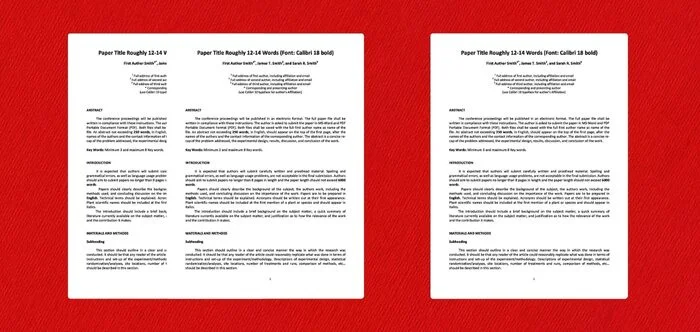In the academic world, distinguishing between various types of scholarly documents is crucial for researchers and students. A common question arises: “How do you know if a paper is a conference paper?” We must understand the fundamental differences between a conference paper and other academic documents to answer this.
A conference paper is specifically written for publication in the proceedings of a conference. It is a formal record of the research presented and discussed at these scholarly meetings. Contrasting this, a presentation is an oral summary of the paper’s key points, delivered to an audience during the conference.
By understanding these distinctions, one can easily identify a conference paper. Dive deeper into our article to explore the nuances of conference papers and learn how to recognize them effectively in the academic landscape.
Significance of the Conference Paper Nowadays
Today, conference papers play a more crucial role than ever in the fast-paced academic environment. They are not just documents but beacons of knowledge, pushing the boundaries of research and collaboration. Their significance is multi-faceted, impacting various aspects of scholarly work and communication.
- Rapid Dissemination of Research: Conference papers enable swift sharing of recent findings, which is crucial in rapidly advancing fields.
- Networking Catalysts: They facilitate networking, connecting researchers, and fostering collaborations vital for scientific progress.
- Benchmark for Emerging Trends: These papers act as benchmarks, signaling emerging trends and shaping future research directions in their respective fields.
- Professional Development Tools: Presenting at conferences such as arts and educational conferences aids professional growth, enhancing researchers’ presentation skills and academic reputation.
- Educational Value: Conference papers serve as contemporary educational resources, offering students insights into the latest research and methodologies.
The role of conference papers in modern academia is more prominent than ever. They not only disseminate knowledge but also foster connections, indicate trends, aid in professional development, and serve as learning tools. Their evolving significance is a testament to their enduring impact on the scholarly community.
A Conference Paper- What Does it Contain?
A conference paper is a unique academic document, distinct in its structure and content. It’s crafted to concisely convey research findings and provoke discussion within a scholarly community. Understanding its components is key to appreciating its role in academic discourse.
- Title and Author Information: The title succinctly encapsulates the paper’s focus. Author details include affiliations, highlighting their institutional or organizational backgrounds.
- Abstract: A concise summary of the paper, the abstract outlines key points and findings. It provides a snapshot of the research’s significance and scope.
- Introduction: This section sets the context, introducing the research question and its importance. It lays the groundwork for understanding the study’s aims and objectives.
- Methodology: Here, the methods used in the research are detailed. This includes the approach, materials, and processes employed in the study.
- Results: The results section presents the findings of the research. It focuses on data and observations gathered during the study.
- Discussion: This part interprets the results, discussing their implications. It connects the findings to existing knowledge and potential future research.
- Conclusion: Summarizing the paper, the conclusion reiterates key findings. It may also suggest directions for further research or practical applications.
- References: This section lists the works cited in the paper. It provides a bibliography of sources that support the research.
A conference paper is a meticulously structured document, each section playing a vital role in presenting research. From introducing the topic to discussing its broader implications, it serves as a comprehensive yet concise academic work. Understanding these components helps in both creating and evaluating such papers effectively.
How Do You Know if a Paper is a Conference Paper?
Academic papers come in various forms, each serving a unique purpose in the scholarly community. Among these, conference papers hold a special place, often marking the forefront of research and discussion in various fields. To distinguish a conference paper from other academic documents, consider the following steps:
Step 1: Check the Publication Venue
A conference paper is typically published in the proceedings of a specific conference. If you find a paper within such proceedings, it’s likely a conference paper. These proceedings are usually a collection of all the papers presented at a conference.
Step 2: Look for Conference Details
Conference papers often include information about the conference itself, such as the name, date, and location of the event. This information is usually found on the first page or in the header/footer of the paper.
Step 3: Evaluate the Format and Length
Conference papers generally have a shorter format compared to journal articles. They are concise, focusing on key findings and methodologies, and usually span a few pages, aligning with typical conference presentation time limits.
Step 4: Assess the Content Focus
These papers often present preliminary findings, innovative ideas, or ongoing research, indicative of their role in fostering immediate discussion and feedback within the conference setting.
Step 5: Investigate the Author’s Affiliation
Authors of conference papers are often affiliated with academic institutions and might mention their participation in a specific conference related to the paper.
Step 6: Review Citations and References
Look at how the paper is cited in other works. References to a conference, symposium, or workshop in citations can indicate that the paper is a conference paper.
Identifying a conference paper is a skill that enhances your understanding and navigation of academic literature. By following these steps, you can effectively distinguish conference papers from other types of academic writing, enriching your research and knowledge in your field of interest.
Characteristics of a Conference Paper
Conference papers are a unique form of academic literature, characterized by specific features that set them apart from other scholarly writings. They play a pivotal role in the dissemination of research and knowledge in various academic fields. Recognizing these characteristics is essential for understanding their impact and purpose.
- Focused and Concise: Conference papers are typically brief, focusing sharply on a specific aspect of research. They succinctly present key findings and methodologies, aligning with the limited presentation time at conferences.
- Preliminary Findings: Often, these papers introduce preliminary results or ongoing research. This makes them a platform for immediate feedback and discussion within the academic community.
- Formal Structure: They adhere to a formal structure, usually including an abstract, introduction, methodology, results, and conclusion. This format aids in delivering clear and organized content to the audience.
- Timely Publication: Conference papers are published rapidly, often within the conference proceedings. This timely release ensures the quick dissemination of current and relevant research.
- Peer-Reviewed: Many conference papers undergo a peer-review process, though it might be less rigorous than journal articles. This review ensures the quality and relevance of the research presented.
- Presentation-Oriented: Designed for oral presentation, these papers are crafted to engage and inform a live audience. They often include visual aids like slides or posters to enhance understanding.
Understanding the characteristics of a conference paper is key to appreciating its role in academic discourse. These features reflect the paper’s purpose to share, discuss, and develop new ideas in a dynamic and interactive setting. Recognizing these traits helps in both producing and assessing conference papers effectively.
What is the General Usage of the Conference Paper?
Conference papers are a cornerstone in the academic and professional world, serving multiple roles across various disciplines. They are not only a medium for sharing new research but also a platform for networking and discussion. Understanding their general usage and types offers insights into their significance in scholarly communication.
Disseminating Cutting-Edge Research
Conference papers often present the latest research findings, offering a first glimpse into new studies and theories. They provide a rapid and timely dissemination of innovative ideas, usually before they appear in detailed journal articles.
Fostering Academic Networking
These papers serve as a catalyst for academic networking. Presenting a paper at a conference allows researchers to connect with peers, sparking collaborations and discussions that can lead to significant scientific advancements.
Gauging Research Trends and Directions
Conference papers are instrumental in indicating current trends and future directions in research. They reflect the dynamic nature of a field, highlighting evolving theories, methodologies, and areas of interest among scholars.
Contributing to Professional Development
For many academics, presenting a conference paper is a key part of professional development. It provides an opportunity to hone presentation skills, receive feedback, and enhance their visibility in the academic community.
Serving as Educational Resources
Often, conference papers are used as educational resources. They offer students and early-career researchers insights into the latest research and methodologies, serving as a valuable learning tool.
Conference papers play diverse and critical roles in the academic landscape. From sharing pioneering research to fostering professional growth, they are an integral part of scholarly communication and development. Understanding their usage enriches one’s appreciation of their importance in academic and professional circles.
Final Words
In the quest to understand “How do you know if a paper is a conference paper?” we’ve explored the unique nature and significant roles of conference papers in academia. These papers are pivotal in rapidly disseminating cutting-edge research, fostering vital academic networking, and marking emerging trends in various fields.
Their structured composition, concise, focused, and often presenting preliminary findings, distinguishes them in scholarly communication. Identifying a conference paper involves examining its publication venue, format, content focus, and author affiliations, emphasizing the need for meticulous attention to detail.
Misidentifying or inaccurately categorizing such papers can lead to their context and significance misunderstandings. Hence, recognizing these aspects is not only crucial for academic clarity but also for ensuring the integrity and progression of scholarly work.







